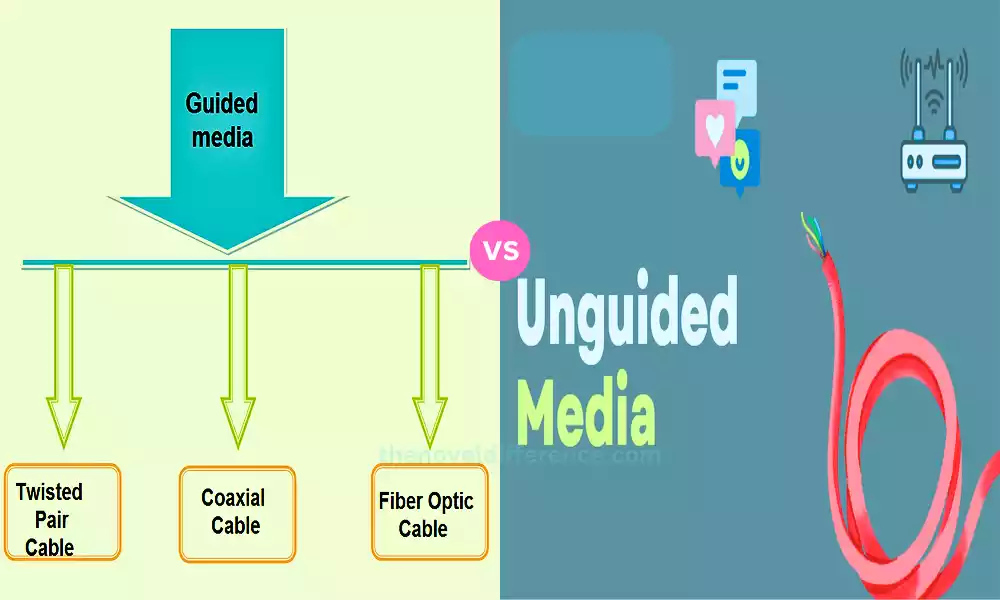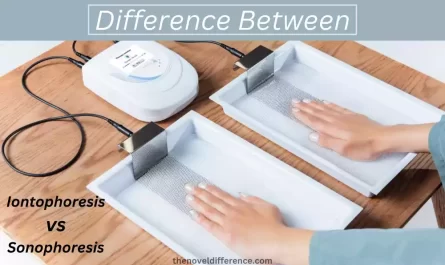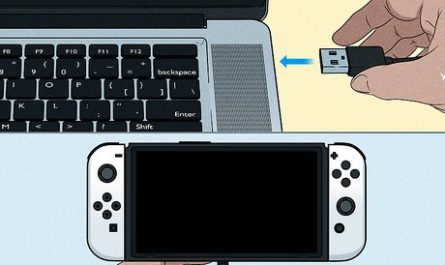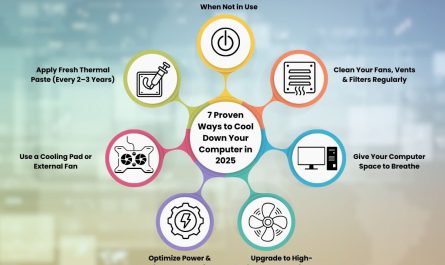Data transmission plays a pivotal role in modern communications. Guided Media and Unguided Media are two fundamental types of transmission channels that facilitate the movement of data from one point to another. Understanding the differences between these media is essential for choosing the right communication technology for specific applications. This article explores guided media and unguided media, their characteristics, use cases, and advantages.
Definition of guided media
Guided media, also known as bounded media or wired media, refers to a type of communication transmission medium through which data signals or information travel in a guided manner.
In guided media, the signals are confined within physical cables or pathways, which serve as a conduit for transmitting data from one point to another. These cables provide a well-defined, controlled, and stable path for the signals, ensuring minimal signal loss and interference during transmission.
Guided media typically use electrical or optical signals to carry data and are commonly used in wired communication systems. The most common types of guided media include twisted pair cables, coaxial cables, and optical fibers.
Each type of guided medium has its unique properties, such as data transmission rates, maximum distance, and resistance to external interference, making them suitable for different applications based on specific communication needs. Guided media is frequently employed in local area networks (LANs), wide area networks (WANs), and various point-to-point or multipoint communication scenarios.
Definition of unguided media
Unguided media, also known as unbounded media or wireless media, refers to a type of communication transmission medium through which data signals or information travel without the need for physical cables or pathways. In unguided media, the signals propagate through free space, typically using various forms of electromagnetic waves, to transmit data from one point to another.
Unlike guided media, which rely on physical cables to guide and contain the signals, unguided media utilize air or vacuum as the transmission medium. These wireless signals travel freely through the atmosphere or space, enabling communication between devices without the constraints of physical connections.
Unguided media includes various types of wireless communication technologies, such as radio waves, microwaves, infrared, and satellite communication. Each of these forms of unguided media has different characteristics and applications.
Radio waves and broadcasting services often use radio waves; microwaves provide point-to-point links; infrared light is typically employed for short-range communications between devices (i.e. remote controls); satellite communication allows long-distance transmission from Earth orbit to orbiting satellites;
Unguided media offers advantages such as mobility, flexibility, and easy setup since it eliminates the need for physical cables. However, it is more susceptible to external interference and may have limited coverage or data transmission rates compared to guided media.
Unguided media plays a crucial role in modern wireless communication systems, supporting various applications ranging from mobile devices and wireless networks to satellite communication and remote sensing.
Importance of understanding the differences between Guided Media and Unguided Media
Understanding the differences between guided media and unguided media is essential for several reasons, as outlined below:
1. Technology Selection: Knowing the disparities between the two types of media helps individuals and organizations choose the most suitable communication technology for their specific needs. Factors such as data transmission rates, distance requirements, susceptibility to interference, and installation costs can significantly impact the selection process.
2. Network Design and Implementation: When designing and setting up communication networks, whether for home, office, or large-scale infrastructure, understanding the differences between guided and unguided media assists in making informed decisions and assuring optimal network performance in terms of performance, reliability, and cost efficiency.
3. Signal Propagation and Interference: Guided media and unguided media have distinct characteristics regarding signal propagation and susceptibility to interference. This knowledge aids in predicting and mitigating potential signal degradation and interference issues, improving the overall quality and reliability of communication systems.
4. Data Security: Guided media, being physically confined, generally provides better data security compared to unguided media, which propagates signals wirelessly through free space. Understanding this difference is crucial for sensitive applications where data security is a top priority.
5. Network Performance: The differences in data transmission rates and range between guided and unguided media directly impact network performance. Knowing these distinctions helps in planning and optimizing network performance to meet the required data transfer speeds and coverage area.
6. Troubleshooting and Maintenance: In the event of network issues, understanding whether the network employs guided or unguided media can streamline troubleshooting processes. Different media types may require different diagnostic techniques and maintenance procedures.
7. Advancements and Innovation: Awareness of the differences between guided and unguided media keeps individuals and professionals updated with the latest advancements and innovations in communication technologies. This knowledge can open opportunities for adopting new technologies that might better suit evolving communication needs.
8. Resource Management: Understanding the strengths and limitations of guided and unguided media allows for efficient resource management. By utilizing the appropriate technology in specific scenarios, resources like bandwidth, equipment, and costs can be optimized.
9. Integration and Interoperability: In many cases, communication networks may involve a combination of guided and unguided media. Understanding the differences aids in integrating and ensuring interoperability between different components of a hybrid network.
10. Regulatory and Compliance Requirements: Different communication technologies may be subject to various regulatory and compliance standards. Being aware of the distinctions helps in meeting these requirements and ensuring adherence to industry-specific guidelines.
Understanding the differences between guided media and unguided media is integral for making well-informed decisions, optimizing network performance, safeguarding data security, and remaining up-to-date with evolving communication technologies.
Knowing these distinctions enables individuals and organizations to build reliable communications systems tailored specifically toward meeting individual needs and requirements.
Guided Media
Guided media, also known as bounded media or wired media, refers to a type of communication transmission medium that utilizes physical cables or conductors to transmit data signals from one point to another. In guided media, the signals are confined and headed along the path of the cables, ensuring minimal signal loss and interference during transmission.
There are several types of guided media commonly used in communication systems:
Twisted Pair: Twisted pair cables consist of two insulated copper wires twisted together in a helical manner. They are commonly used for telephone lines and Ethernet connections in local area networks (LANs). Twisted pair cables are relatively inexpensive and easy to install, making them a popular choice for short-distance communication.
Coaxial Cable: Coaxial cables consist of a central copper conductor surrounded by an insulating layer, a shield, and an outer jacket. The shield protects against external interference and allows for higher data transmission rates over longer distances compared to twisted pair cables. Coaxial cables are widely used in cable television (CATV) systems and broadband internet connections.
Optical Fiber: Optical fibers are made of glass or plastic and use light pulses to transmit data. They offer very high data transmission rates over long distances and are immune to electromagnetic interference. Optical fibers are commonly used in high-speed internet connections, long-distance communication links, and in networking backbones.
Characteristics and features of guided media include:
a. Transmission Mode: Guided media offers both half-duplex and full-duplex transmission modes, permitting data transmission in both directions at once or alternately.
b. Signal Attenuation: Guided media experiences signal attenuation, which is the reduction of signal strength over distance. The type of cable used and the distance covered can affect the extent of signal attenuation.
c. Signal Interference: Guided media is less susceptible to external interference since the signals are contained within the physical cables, reducing the impact of electromagnetic interference from other devices or external sources.
d. Data Transmission Rates: The data transmission rates of guided media can vary depending on the type of cable used. Optical fibers offer the highest data transmission rates, followed by coaxial cables and twisted pair cables.
e. Installation: Guided media typically requires physical installation, which involves laying cables and connecting them to devices. This process may be more time-consuming and labor-intensive compared to wireless (unguided) media.
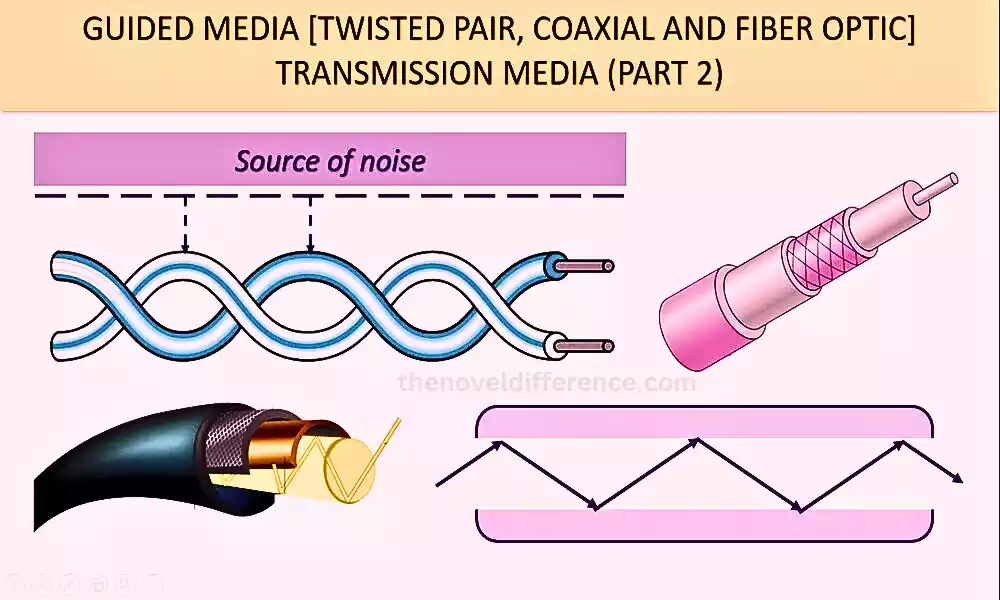
Guided media is commonly employed in local area networks (LANs), wide area networks (WANs), and point-to-multipoint communications where its stability, reliability, and predictable performance are imperative.
Explanation of guided media
Guided media, also known as bounded media or wired media, is a type of communication transmission medium that uses physical cables or conductors to transport data signals from one point to another.
Unlike unguided media (wireless media), which propagates signals through free space, guided media confines and directs the signals along the path of the cables, providing a controlled and stable transmission environment.
The primary types of guided media include:
1. Twisted Pair: Twisted pair cables consist of two insulated copper wires twisted together in a helical configuration. The twisting helps to reduce electromagnetic interference and crosstalk, which occurs when signals from one pair interfere with adjacent pairs. Twisted pair cables are commonly used for telephone lines, Ethernet connections in local area networks (LANs), and some audio and video applications.
2. Coaxial Cable: Coaxial cables consist of a central copper conductor, surrounded by an insulating layer, a braided or foil shield, and an outer jacket. The shield protects the central conductor from external interference and prevents electromagnetic radiation from escaping the cable. Coaxial cables are commonly used in cable television (CATV) systems, high-speed internet connections, and some networking applications.
3. Optical Fiber: Optical fibers are made of glass or plastic and use pulses of light to transmit data. They consist of a core, where light travels, surrounded by a cladding that reflects the light into the core. The core and cladding are enclosed within an outer protective coating. Optical fibers offer high data transmission rates, low signal attenuation over long distances, and immunity to electromagnetic interference. Wireless communication links and high-speed internet connections are commonly utilized as networking backbones.
Guided media has several key characteristics and features:
a. Signal Propagation: In guided media, the signals travel through the physical cables as electrical or optical impulses. Cables provide an unobstructed path for signals, helping ensure they reach their destination without significant signal degradation.
b. Signal Attenuation: Guided media experiences signal attenuation, which is the weakening of the signal as it travels over a distance. Signal attenuation depends upon both the cable type used and the distance covered, making its effect variable depending on these two factors.
c. Interference: Guided media is less susceptible to external interference because the signals are confined within the cables. This confinement reduces the impact of electromagnetic interference from other devices or external sources.
d. Data Transmission Rates: The data transmission rates of guided media depend on the type of cable used. Optical fibers offer the highest data transmission rates, followed by coaxial cables and twisted pair cables.
e. Installation: Guided media requires physical installation, which involves laying cables and connecting them to the devices. This process may be more time-consuming and labor-intensive compared to wireless media.
Guided media has long been used in various communication systems, from local area networks (LANs) and wide area networks (WANs), to other applications where stable, reliable connections with predictable performance are essential. It provides secure and high-bandwidth communication, making it suitable for scenarios where data integrity and speed are critical.
Types of guided media
Guided media, also known as bounded media or wired media, encompasses several types of physical cables used for transmitting data signals in communication systems.
The primary types of guided media include:
1. Twisted Pair Cable:
Description: Twisted pair cable consists of two insulated copper wires twisted together in a helical configuration.
Types: There are two main categories of twisted pair cables:
a. Unshielded Twisted Pair (UTP): This type of cable has no external shielding and is commonly used for Ethernet connections in the home and office networks.
b. Shielded Twisted Pair (STP): STP includes a foil or braided shield around the twisted pairs, offering better protection against electromagnetic interference. It is used in environments with higher interference levels.
2. Coaxial Cable:
Description: Coaxial cable has a central copper conductor surrounded by an insulating layer, a shield, and an outer protective jacket.
Types: Coaxial cables can be categorized into different classes based on their impedance and applications:
a. 50-ohm Coaxial Cable: Commonly used in data communication applications such as Ethernet, video transmission, and some high-frequency signaling.
b. 75-ohm Coaxial Cable: Widely used in cable television (CATV) systems, video applications, and digital audio connections.
3. Optical Fiber:
Description: Optic fibers, usually constructed of glass or plastic, use pulses of light to transmit information along their cores.
Types: Optical fibers can be classified into two main types based on the refractive index profile:
a. Multimode Fiber (MMF): Has a larger core, allowing multiple modes of light to propagate. Used for short-distance communication, such as within buildings or campuses.
b. Single-mode Fiber (SMF): Has a smaller core, enabling only one mode of light to propagate. Suited for long-distance communication, such as telecommunication networks and high-speed internet backbones.
4. Waveguides:
Description: Waveguides are hollow metal tubes or dielectric structures that guide electromagnetic waves, typically used in high-frequency applications.
Types: Waveguides can be categorized based on their shape and mode of propagation.
a. Rectangular Waveguide: Characterized by a rectangular cross-section, commonly used in microwave communication and radar systems.
b. Circular Waveguide: Has a circular cross-section, used for satellite communication and certain microwave applications.
Each type of guided media offers distinct advantages and is suitable for specific communication requirements. The selection of guided media depends on factors such as data transmission rates, distance, susceptibility to interference, and cost considerations.
Guided media is commonly used in local area networks (LANs), wide area networks (WANs), and other communication systems where stability, reliability, and control signal transmission are crucial.
Unguided Media
Unguided media, also known as unbounded media or wireless media, refers to a type of communication transmission medium that does not require physical cables or conductors for transmitting data signals. Instead, unguided media utilizes various forms of electromagnetic waves to propagate signals through free space from one point to another.
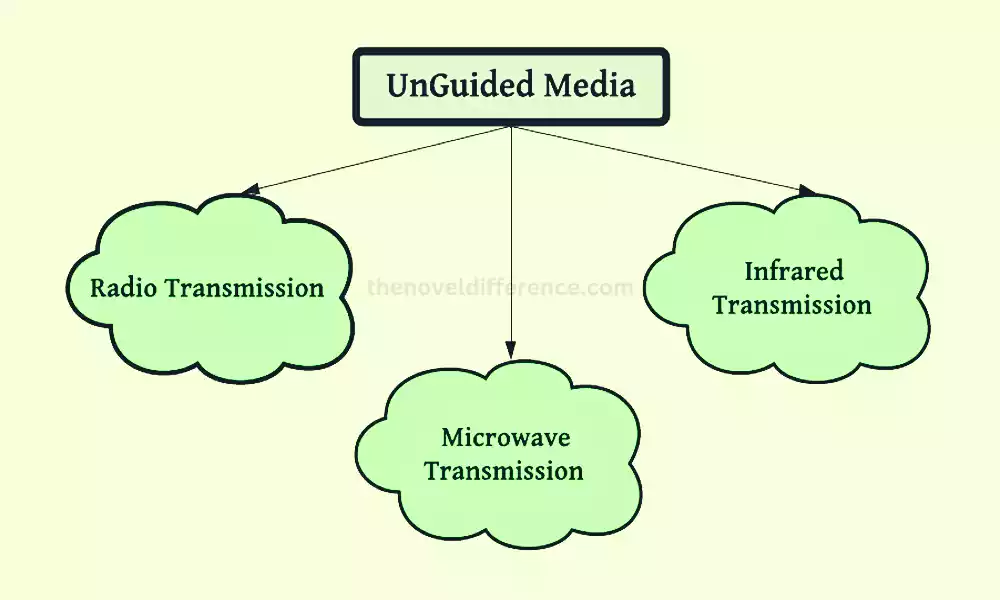
The primary types of unguided media include:
1. Radio Waves:
Description: Radio waves are electromagnetic waves with relatively long wavelengths, ranging from several centimeters to several meters.
Applications: Radio waves have long been utilized as a form of wireless communication technology, from radio broadcasting and cell networks, through Wi-Fi (Wireless Fidelity) networks and Bluetooth systems, among others.
2. Microwaves:
Description: Microwaves are electromagnetic waves with shorter wavelengths than radio waves; typically between several millimeters to several centimeters in duration.
Applications: Microwaves are frequently employed for point-to-point communication links such as satellite communications, microwave backhauls, and some wireless data transmission applications.
3. Infrared:
Description: Infrared waves feature shorter wavelengths than microwaves, from just millimeters up to 750 nanometers.
Applications: Infrared is often used for short-range wireless communication between devices, such as in remote controls, infrared data transfer between smartphones, and infrared communication in certain sensor networks.
4. Satellite Communication:
Description: Satellite communication involves transmitting and receiving signals between Earth-based stations and communication satellites circling Earth.
Applications: Satellite communications serve several different needs, from long-distance links and broadcast television, to rural internet services, and global positioning systems (GPS).
5. Characteristics and features of unguided media include:
a. Propagation of Signals: Unguided media propagates data signals through free space as electromagnetic waves. The signals travel in a straight line unless they encounter obstacles or are redirected by reflective surfaces.
b. Signal Attenuation and Dispersion: Signals in unguided media experience attenuation, which causes the signal strength to decrease over distance. Additionally, some types of unguided media, like microwaves, may suffer from signal dispersion, where different components of the signal travel at different speeds.
c. Susceptibility to External Interference: Unguided media is more susceptible to external interference than guided media. Factors such as environmental conditions and other electromagnetic sources can impact the quality of signal transmission.
d. Mobility and Flexibility: The absence of physical cables in unguided media allows for greater mobility and flexibility in communication. Wireless communication enables devices to interact without being physically linked, opening up an array of applications for mobile and portable devices.
Unguided media plays a critical role in modern wireless communication systems, supporting various applications such as mobile communication, wireless networking, remote sensing, and satellite communication.
Its advantages include flexibility, mobility, and ease of deployment, making it suitable for scenarios where physical connections are impractical or limited. However, it may face challenges related to signal interference, security, and coverage limitations compared to guided media.
Explanation of unguided media
Unguided media, also known as unbounded media or wireless media, is a type of communication transmission medium that does not rely on physical cables or conductors to transmit data signals. Instead, unguided media uses various forms of electromagnetic waves to propagate signals through free space from one point to another.
These waves travel through the atmosphere or the vacuum of space to carry information between transmitting and receiving devices.
There are several types of unguided media commonly used in communication systems:
1. Radio Waves:
Description: Radio waves are electromagnetic waves with relatively long wavelengths, ranging from several centimeters to several meters.
Applications: Radio waves have long been used for wireless communication purposes, including radio broadcasting, cell networks, walkie-talkies, and data transmission over wireless.
2. Microwaves:
Description: Microwaves are electromagnetic waves with shorter wavelengths than radio waves; typically between one millimeter to several centimeters in wavelength.
Applications: Microwaves are increasingly utilized as point-to-point communication links, including satellite communication, microwave backhauls, and radar systems.
3. Infrared:
Description of Infrared Waves (IRWs): Infrared waves possess shorter wavelengths than microwaves; typically between several millimeters to about 750 nanometers.
Applications: Infrared is often used for short-range wireless communication between devices, such as in remote controls, infrared data transfer between smartphones, and certain sensor networks.
4. Satellite Communication:
Description: Description of Satellite Communication: Satellite communication involves transmitting signals between Earth-based stations and communication satellites that orbit around our planet.
Applications: Satellite communication serves multiple functions, from long-distance communications links and television broadcasting to internet service in remote areas and global positioning systems (GPS).
5. Characteristics and features of unguided media include:
a. Propagation of Signals: Unguided media propagates data signals through free space as electromagnetic waves. These waves travel in straight lines and may be reflected, refracted, or diffracted by obstacles and atmospheric conditions.
b. Signal Attenuation and Dispersion: Signals in unguided media experience attenuation, which causes the signal strength to decrease over distance. Additionally, certain types of unguided media, like microwaves, may suffer from signal dispersion, where different components of the signal travel at different speeds.
c. Susceptibility to External Interference: Unguided media is more susceptible to external interference than guided media since the signals travel freely through the environment. Factors such as environmental conditions and other electromagnetic sources can impact the quality of signal transmission.
d. Mobility and Flexibility: The absence of physical cables in unguided media allows for greater mobility and flexibility in communication. Wireless communication enables devices to share information without physical connection, opening up many opportunities in mobile and portable applications.
Unguided media plays a crucial role in modern wireless communication systems, supporting various applications such as mobile communication, wireless networking, remote sensing, and satellite communication.
Its advantages include flexibility, mobility, and ease of deployment, making it suitable for scenarios where physical connections are impractical or limited. However, it may face challenges related to signal interference, security, and coverage limitations compared to guided media.
Types of unguided media
Unguided media, also known as unbounded media or wireless media, encompasses various types of communication transmission media that propagate data signals through free space using electromagnetic waves.
The primary types of unguided media include:
1. Radio Waves:
Description: Radio waves are electromagnetic waves with relatively long wavelengths, ranging from several centimeters to several meters.
Applications: Radio waves are used extensively for wireless communication purposes, from broadcast radio and cellular network service provisioning through walkie-talkies, Wi-Fi data transmission networks, and Bluetooth connections to broadcast television broadcasting and wireless walkie-talkies.
Microwaves:
Description: Microwaves are electromagnetic waves with shorter wavelengths than radio waves; typically from millimeters to centimeters in length.
Applications: Microwaves are commonly used for point-to-point communication links, such as satellite communication, microwave backhauls for internet and telephone traffic, and radar systems.
2. Infrared Waves:
Description: Infrared waves feature shorter wavelengths than microwaves, typically from several millimeters up to approximately 750 nanometers.
Applications: Infrared is often used for short-range wireless communication between devices, such as in remote controls, infrared data transfer between smartphones, and certain sensor networks.
3. Visible Light Communication (VLC):
Description: VLC, also known as Li-Fi (Light Fidelity), utilizes visible light to transmit data between devices.
Applications: VLC is used in indoor environments where LED lights are used for both illumination and data communication, offering high-speed, secure, and interference-free communication.
4. Ultraviolet Waves:
Description: Ultraviolet waves have even shorter wavelengths than infrared waves, ranging from about 10 nanometers to 400 nanometers.
Applications: Ultraviolet waves have limited communication applications, but they are used in specific niche areas, such as in certain scientific and industrial applications.
5. Terahertz Waves:
Description: Terahertz waves have even shorter wavelengths than microwaves, ranging from about 1 millimeter to 1 micrometer.
Applications: Terahertz waves are currently being researched as potential tools for wireless data communications and imaging applications; however, their development remains relatively novel.
6. Satellite Communication:
Description: Satellite communication involves transmitting and receiving signals between Earth-based stations and communication satellites orbiting around Earth.
Applications: Satellite communications serve a multitude of uses, spanning long-distance calls and television broadcasts to internet service provision in remote areas and global positioning systems (GPS), among others.
Each type of unguided media has its own unique characteristics, advantages, and limitations, making them suitable for specific communication applications. These technologies play a central role in modern wireless communication systems, offering mobility, flexibility, and an array of uses across numerous industries and everyday activities.
Comparison Between Guided and Unguided Media
Comparing guided and unguided media is crucial for understanding their respective strengths and weaknesses, which can help in selecting the most appropriate communication medium for specific applications.
Below is a comparison between guided and unguided media based on various factors:
- Transmission Medium:
- Guided Media: Uses physical cables or conductors to guide and transmit data signals from one point to another.
- Unguided Media: Relies on electromagnetic waves to propagate data signals through free space without the need for physical cables.
- Signal Propagation:
- Guided Media: Signals in guided media are confined within the cables, ensuring a controlled and predictable path of transmission.
- Unguided Media: Signals in unguided media travel through the atmosphere or vacuum of space, propagating in straight lines or being influenced by reflections, diffractions, and other environmental factors.
- Range and Coverage:
- Guided Media: Generally has limited range, especially for copper-based cables like twisted pair and coaxial cables. Optical fibers offer longer distances but still have practical limitations.
- Unguided Media: This can provide greater range, especially in the case of satellite communication, where signals can cover vast distances.
- Data Transmission Rates:
- Guided Media: Optical fibers offer high data transmission rates and can support very high bandwidths compared to twisted pair and coaxial cables.
- Unguided Media: Data transmission rates can be high, particularly in the case of microwaves and satellite communication, but they may not match the bandwidth capabilities of optical fibers.
- Signal Attenuation:
- Guided Media: Signal attenuation occurs in guided media due to factors like resistance, capacitance, and inductance in the cables, leading to some loss of signal strength over distance.
- Unguided Media: Signal attenuation can also occur in unguided media as the signal travels through the atmosphere, which can lead to signal degradation over long distances.
- Susceptibility to Interference:
- Guided Media: Generally less susceptible to external interference since the signals are confined within the physical cables.
- Unguided Media: More susceptible to external interference due to the open propagation of signals through free space, making them prone to environmental factors, other wireless devices, and electromagnetic noise.
- Installation and Maintenance:
- Guided Media: Requires physical installation of cables, which can be more time-consuming and labor-intensive. Maintenance involves checking and repairing physical connections.
- Unguided Media: Installation is relatively easier and faster since it does not require physical cables. Maintenance often involves managing frequency allocations and optimizing wireless device configurations.
- Mobility and Flexibility:
- Guided Media: Generally lacks mobility and flexibility due to the physical connections, making it more suitable for fixed installations.
- Unguided Media: Offers high mobility and flexibility, making it ideal for mobile devices, wireless networks, and portable communication.
Guided media provides controlled and stable communication with predictable performance but may have limited range and bandwidth. On the other hand, unguided media offers greater mobility and flexibility but can be more susceptible to interference and may have some limitations on range and data rates.
The choice between guided and unguided media depends on specific communication needs, distance requirements, data transmission rates, susceptibility to interference, and other factors related to the application.
Choosing Between Guided and Unguided Media
Choosing between guided and unguided media depends on various factors and specific communication requirements.
Below are key considerations to help decide which type of media is more suitable for a particular application:
- Distance of Transmission:
- Guided Media: Guided media, especially optical fibers, is better suited for long-distance communication due to its lower signal attenuation. It is ideal for scenarios where data needs to be transmitted over significant distances with minimal loss of signal strength.
- Unguided Media: Unguided media, such as satellite communication or microwaves, can also support long-distance transmission. Satellite communication, in particular, is well-suited for global coverage.
- Data Transmission Rates:
- Guided Media: Optical fibers offer the highest data transmission rates, making them the preferred choice for applications requiring ultra-high bandwidth, such as high-speed internet connections and data-intensive networking.
- Unguided Media: Unguided media, like Wi-Fi and microwave links, can provide sufficient data transmission rates for many applications, including wireless internet access and streaming multimedia content.
- Signal Attenuation and Interference:
- Guided Media: Guided media generally experiences less signal attenuation and is less susceptible to external interference since signals are confined within the physical cables.
- Unguided Media: Unguided media can face higher signal attenuation and is more susceptible to interference due to the open propagation of signals in the atmosphere. However, advancements in wireless technologies and signal processing have significantly improved the reliability and performance of unguided media.
- Mobility and Flexibility:
- Guided Media: Guided media lacks mobility and flexibility as it requires physical cables, making it more suitable for fixed installations and static communication networks.
- Unguided Media: Unguided media offers high mobility and flexibility, making it ideal for mobile devices, wireless networks, and scenarios where mobility is essential, such as in portable communication.
- Environmental Factors:
- Guided Media: Guided media can be affected by environmental factors like moisture, temperature, and physical damage to the cables. It may require protective sheathing or underground installations in harsh environments.
- Unguided Media: Unguided media can also be influenced by environmental conditions, particularly atmospheric effects on wireless signals. However, it generally requires less physical infrastructure and is more adaptable to changing environments.
- Installation and Maintenance:
- Guided Media: Guided media requires the physical installation of cables, which can be more time-consuming and labor-intensive. It may also involve periodic maintenance to check and repair physical connections.
- Unguided Media: Unguided media has relatively easier and faster installation since it does not require physical cables. Maintenance often involves managing frequency allocations and optimizing wireless device configurations.
- Cost Considerations:
- Guided Media: The cost of guided media can include the expenses associated with purchasing and installing physical cables, connectors, and networking infrastructure.
- Unguided Media: Unguided media may involve lower installation costs since it does not require physical cables. However, the cost of wireless devices and infrastructure, such as routers and access points, should be considered.
Ultimately, the choice between guided and unguided media should be based on a thorough assessment of the specific communication requirements, distance considerations, data transmission rates, susceptibility to interference, mobility needs, environmental factors, and overall cost considerations of the application.
In many cases, a combination of both guided and unguided media may be used to create a hybrid communication network that leverages the advantages of both types of media for optimal performance and coverage.
Conclusion
Understanding the differences and characteristics of guided and unguided media is vital for making informed decisions in communication technology selection. Guided media relies on physical cables to guide and transmit data signals, providing controlled and stable communication with predictable performance.
Twisted pair cables, coaxial cables, and optical fibers are common examples of guided media, each offering different transmission capabilities.
Unguided media propagates data signals through free space using various forms of electromagnetic waves. Radio waves, microwaves, infrared, visible light communication (VLC), and satellite communication are examples of unguided media, offering advantages like mobility, flexibility, and ease of deployment.

